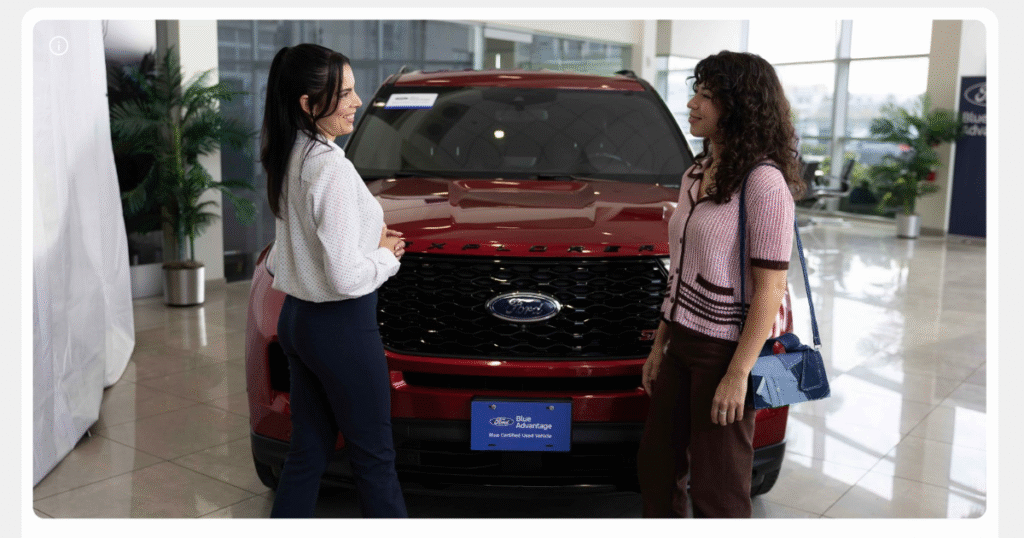Customers want the convenience of digital combined with the confidence of in person touchpoints. Trust, without the hassle of legacy processes. That is the bet Ford Motor Company is making with their move to make Certified preowned Ford vehicles available through Amazon. The partnership is starting in Los Angeles, Seattle, and Dallas with around 20 dealerships already launched or launching soon.
Despite the partnership, and Andy Jassy’s recent remarks that a large share of what is now in store retail will shift to online or digitally enabled channels in the years ahead, businesses should stop thinking of online vs. in store. At the same time, online marketplaces are becoming discovery and transaction engines for high consideration purchases, not just low friction goods. Moving forward businesses will need to navigate hybrid retail journeys.
TL;DR
- Hybrid retail journeys blend digital discovery with physical fulfillment.
- Online marketplaces are becoming engines for high consideration purchases.
- Dealerships stay involved but lose pieces of the customer journey.
- Data access is the biggest strategic risk for manufacturers and dealers.
- The future is the platform dealership, where physical showrooms plug into digital ecosystems.
What Hybrid Retail Journeys Actually Mean
As customers grow more comfortable buying big ticket items online, manufacturers and dealers need to rethink where the first interaction happens. Ford’s move keeps dealers central, but relocates the shopping journey to where customers already spend time. The physical showroom becomes one stop within a larger digital experience.
This marks the rise of the platform dealership, where the dealership is no longer the origin of the journey. It is a node within a broader ecosystem managed by a platform that handles discovery, comparison, paperwork, and in many cases financing and scheduling.
Why This Shift Matters Now
Big ticket commerce is changing. Consumers expect the same clarity, speed, and transparency they get with other eCommerce categories. Digital platforms are reshaping expectations around pricing, guarantees, availability, and delivery windows.
Ford’s approach gives consumers more confidence and more choice, and it gives dealers a way to participate in the future rather than be bypassed by it.
For manufacturers, it is a strategic reset. The digital channel becomes the front door and the dealership becomes the fulfillment engine.
Where the Risks Show Up
The biggest risk is data. Dealerships may lose key insights that have historically shaped service models, inventory decisions, and long term revenue planning. Even though dealers still own the final fulfillment, they may be shut out of upstream interactions that drive retention and lifetime value.
Another risk is disintermediation. Dealers remain part of the transaction, but they are no longer the primary interface. This shift can reduce leverage and margin unless new capabilities and incentives are built.
Lessons for Companies Navigating Hybrid Journeys
1. Digitize the friction, not the relationship
Let customers browse, compare, and complete paperwork online, while keeping high value conversations human. Retailers that focus on removing pain points without removing the personal connection will outperform.
2. Derisk the transaction to build trust
Digital channels already provide transparency that many consumers feel is missing in the used auto market. Ford is offering customers a clear off ramp with a 14 day or 1,000 mile guarantee. Guarantees reduce uncertainty and speed up decisions.
3. Treat the dealership as a platform node
The physical location becomes part of a larger digital network. This requires new coordination models, data sharing agreements, and operational rhythms that span both environments.
4. Reimagine where value is created
If discovery and financing move online, where do dealerships create future value? Service, personalization, delivery, and local expertise become new differentiators.
5. Build a data strategy before you lose the data
Data access will determine who controls the customer relationship. Companies must define what data they need, how they capture it, and how it flows between partners.
FAQs
What is a hybrid retail journey?
A hybrid retail journey blends digital discovery with physical fulfillment. Customers start online, continue on a marketplace, and complete the transaction in person or through a coordinated delivery process.
Why is this important for big ticket items?
High consideration purchases need trust and transparency. Hybrid journeys offer both clarity and convenience.
Does this weaken dealerships?
It changes their position, but does not eliminate them. Dealerships become part of a larger ecosystem rather than the primary entry point.
Are customers ready to buy big ticket items online?
Consumer comfort continues to rise. Guarantees, transparency, and digital financing accelerate this shift.
What should manufacturers focus on?
Data access, partner alignment, digital brand experience, and clarity around who controls the customer journey.
Conclusion
Hybrid retail journeys are not a compromise between online and in person channels. They are the next dominant retail model for categories where trust and convenience matter equally. Ford’s move with Amazon shows how a platform dealership can reshape the customer journey without removing key partners. The future belongs to companies that can integrate physical expertise with digital access, transparency, and intelligence.
Related content you might also like:
- On Innovation: The Importance of Hybrids
- Of Fathers and Sons…
- 5 Rules for AI-First Shopping
- McDonald’s Digital Transformation: 3 Lessons
- Team Trust: The Key to Well-Functioning Teams


